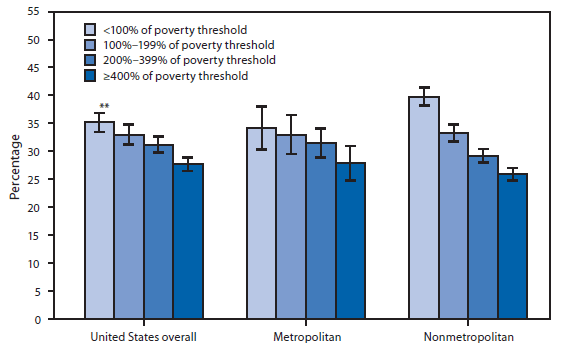QuickStats: Percentage of Adults Who Average ≤6 Hours of Sleep,* by Family Income Group† and Metropolitan Status of Residence§ — National Health Interview Survey, United States, 2013¶

* Participants were asked, "On average, how many hours of sleep do you get in a 24-hour period?"
† Family income groups were defined based on family income as a percentage of the federal poverty threshold. Poverty thresholds, which are published by the U.S. Census Bureau, vary by family size and the number of children in the family. Family income was imputed when missing using multiple imputation methodology.
§ Based on the household residence location. Metropolitan is located within a metropolitan statistical area, defined as a county or group of contiguous counties that contains at least one urbanized area of ≥50,000 population. Surrounding counties with strong economic ties to the urbanized area also are included. Nonmetropolitan areas do not include a large urbanized area and are generally thought of as more rural.
¶ Estimates are based on household interviews of a sample of the civilian, noninstitutionalized U.S. population and are derived from the National Health Interview Survey sample adult component.
** 95% confidence interval.
During 2013, the percentage of adults who slept ≤6 hours in an average 24-hour period declined with family income from 35.2% for those with family incomes <100% of the poverty level to 27.7% for those with family incomes ≥400% of the poverty level. The same pattern was found for those living in metropolitan and nonmetropolitan areas. There were no statistically significant differences between those living in metropolitan and nonmetropolitan areas except among those with family incomes <100% of the poverty level, where 39.8% of adults living in nonmetropolitan areas slept ≤6 hours compared with 34.2% of adults living in metropolitan areas.
Source: National Health Interview Survey, 2013 data. Available at http://www.cdc.gov/nchs/nhis.htm.
Reported by: Lindsey I. Black, MPH, LBlack1@cdc.gov, 301-458-4548; Renee M. Gindi, PhD.
Alternate Text: The figure above is a bar chart showing that during 2013, the percentage of adults who slept ≤6 hours in an average 24-hour period declined with family income from 35.2% for those with family incomes <100% of the poverty level to 27.7% for those with family incomes ≥400% of the poverty level. The same pattern was found for those living in metropolitan and nonmetropolitan areas. There were no statistically significant differences between those living in metropolitan and nonmetropolitan areas except among those with family incomes <100% of the poverty level, where 39.8% of adults living in nonmetropolitan areas slept ≤6 hours compared with 34.2% of adults living in metropolitan areas.
Use of trade names and commercial sources is for identification only and does not imply endorsement by the U.S. Department of
Health and Human Services.
References to non-CDC sites on the Internet are
provided as a service to MMWR readers and do not constitute or imply
endorsement of these organizations or their programs by CDC or the U.S.
Department of Health and Human Services. CDC is not responsible for the content
of pages found at these sites. URL addresses listed in MMWR were current as of
the date of publication.
All MMWR HTML versions of articles are electronic conversions from typeset documents.
This conversion might result in character translation or format errors in the HTML version.
Users are referred to the electronic PDF version (http://www.cdc.gov/mmwr)
and/or the original MMWR paper copy for printable versions of official text, figures, and tables.
An original paper copy of this issue can be obtained from the Superintendent of Documents, U.S.
Government Printing Office (GPO), Washington, DC 20402-9371;
telephone: (202) 512-1800. Contact GPO for current prices.
**Questions or messages regarding errors in formatting should be addressed to
mmwrq@cdc.gov.
 ShareCompartir
ShareCompartir


